


(software extensively reworked and enhanced by Seeds Software July 99, July 00, June 01, Feb 02, Nov 02)
This program can help students and rocketeers understand the physics of water rockets and how to optimize their water rocket launches to obtain the highest apogees. The interface is designed to be easy to use and understand. But don't be fooled by the program's simple layout, few if any of the other simulators you may find are as accurate.
Under the hood this program is pretty sophisticated and thorough. The methodology includes both incompressible and compressible fluid mechanics along with a fair amount of thermodynamics and numerical methods to provide accurate water rocket apogee predictions.
Check out the excellent correlation between simulation and sophisticated high speed digital camera results below (see graphs)
|
This is the latest release of Water Rocket Fun (Ver 3.4).
Select the Water Rocket Fun software file that you can use below and download it to your hard drive. There is no installation, simply expand the archive and double click on the program file to run it.
|

| 
|
In the future look for us to make even more enhancements. If you have any problems or suggestions please get back to us.
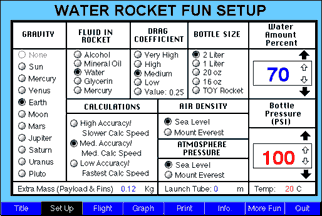
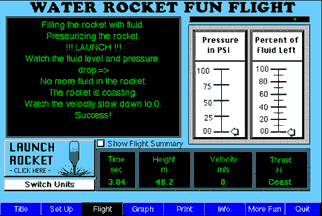
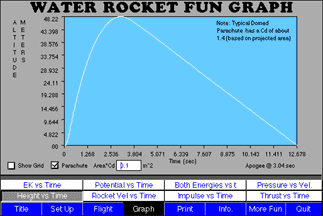
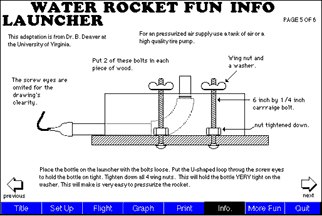
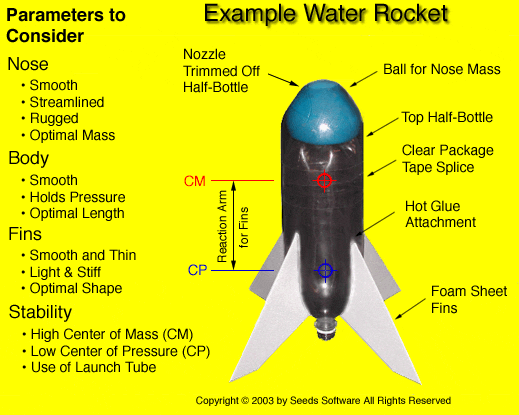
Stable rockets are more efficient and obtain higher apogees. This is because, the more stable the rocket is, the less the rocket wastes energy wobbling about and/or going sideways off course. Hence, the degree of stability any given rocket has is a very important performance factor.
For the typical free flight rocket, the degree of stability inherent in its design is largely dependent on the relative position of the rocket's Center of Mass (CM) to its Center of Pressure (CP). The Center of Mass (CM), also called Center of Gravity (CG), is the central point of balance and rotation for the rocket, while the Center of Pressure (CP) is an averaged point of action for fin and body aerodynamic lift -- a location on the rocket where the summation of all the forces of pressure that develop can be assumed to be acting from. A rocket designer needs to make sure that the Center of Gravity (CG) remains above the Center of Pressure (CP) to keep the rocket stable in flight. This usually requires that more of the rocket's mass is concentrated at the front end of the rocket, while the fins are positioned as far aft as possible to maximize their effectiveness as a stabilizing device. Such an arrangement is stable because the fins are behind the center of rotation, much as they are on a weather vane, where their actions will force the rocket to stay pointed into the direction of air flow. Any time turbulence begins to cause a stable rocket to rotate and veer off its direction of flight, the fins will develop lift forces -- because of the angle of attack they acquire relative to the airflow -- that will act to clock the aft end of the rocket back about the rocket's Center of Gravity until the nose and fins are realigned with the direction of air flow again.
Additionally, in general, the bigger the fins are in the back of the rocket, the more likely the rocket is to remain stable. But bigger fins are also likely to cause additional drag and weight that can work against achieving the highest possible apogees. Hence, some degree of attention to optimizing fin area for stability is also beneficial to performance. A few of the primary factors that influence the degree of stability needed are, the severity of the wind gusts and turbulence in the air, the speed your rocket flies, and the shape and distribution of mass in the rocket nose, body, and fins. Regrettably, theoretically determining the optimum size and shape of the fins needed for stability is a bit involved, and is indefinite in nature, so no further elaboration is given here (consider studying a creditable text book on aerodynamic stability and control design if you desire more advanced and technical insights).
Fortunately, designing rockets to have a suitable degree of stability is remarkably easy. By just paying attention to a few key configuration details, along with performing a simple hands-on check, you can ensure that your designs remain efficient and stable in flight without having to resort to more obscure and often marginal computations and computer programs:
To check your rocket for stability, you can conservatively use a simple spin test. Just tie a length of string around the rocket at its point of balance (CG) with the fins tacked on and use the string to spin the rocket fairly rapidly around in a circle. If the nose of the rocket steadily tracks the circular path you are spinning your rocket around, your fins are definitely sufficient to keep the rocket stable. If not, you may need to make adjustments to the mass of the rocket and/or fin size, location, and shape.
This document may help you to streamline your rockets for optimum performance. It outlines how to do simple cursory investigations into the drag characteristics of your water rockets using a large fan and a triple beam scale as a wind tunnel. Of course these experiments are appropriate for an actual wind tunnel too, which would provide more concise results.
The lab is recommended for grades 9 to 12 (younger students may also do this lab with instructional help and support). If you make use of this lab, and are satisfied with the results, we request that you share your results by submitting them back to Seeds Software for tabulation and possible inclusion at our web site.
The lab is provided as a supplement for the Water Rocket Fun software and serves as a sample of the type of hands-on supporting materials that Seeds Software includes in its educational software packages.
Version 3.4: In Nov '02 Seeds Software added calculations to determine the time required for the rocket to drop back to the ground from its apogee. The new option includes the capability to determine the effects that the deployment of a parachute has on slowing down the rate the rocket falls back to the ground.
Version 3.3: In Feb '02 Seeds Software corrected a calculation error in the rate of mass loss for air release. This correction increases the duration, but not magnitude, of the air thrust. It eliminates a slight deviation between the simulator and test results in the final fractions of a second of thrust that can be observed in earlier version predictions.
Version 3.2: In June '01 Seeds Software added calculations to include the effects of having a launch tube on the launcher. A launch tube fits closely inside the rocket nozzle and goes up into the bottle when the bottle is mounted on the launcher. Using a launch tube will increase the apogee of most rocket launches. The program also considers the effects of sonic choking of the air through the nozzle during the air release stage of thrust.
Sonic choking occurs when a compressible fluid such as air flowing through a constricting nozzle reaches the speed of sound. Generally the air can not be forced to flow faster than the speed of sound through such a nozzle no matter how much pressure is applied. To accelerate air beyond the speed of sound the nozzle shape would have to contract and then expand at a specific rate again (called a Lavel nozzle).
Version 3.1: In July '00 Seeds Software enhanced the program to include the thrust energy provided by the latent heat of the water vapor condensing as the pressurized air expands.
This provides the water rocket with a little extra "pop" off the launch pad and results in about 5% (high pressure) to 20% (low pressure) higher altitude prediction than version 3.0. The predictions made by this version compare very favorably to actual test data that was provided by
Dean Wheeler who captured and processed water rocket launches with a sophisticated high speed digital camera for analysis (Dean's Benchtop).
Version 3.0: In July '99 Seeds Software enhanced the orginal software created by Tony Wayne, to add color, make it cross-platform, and include the thrust provided as the air escapes the bottle (the original and earlier versions did not include this thrust).
Simulation vs Test Results
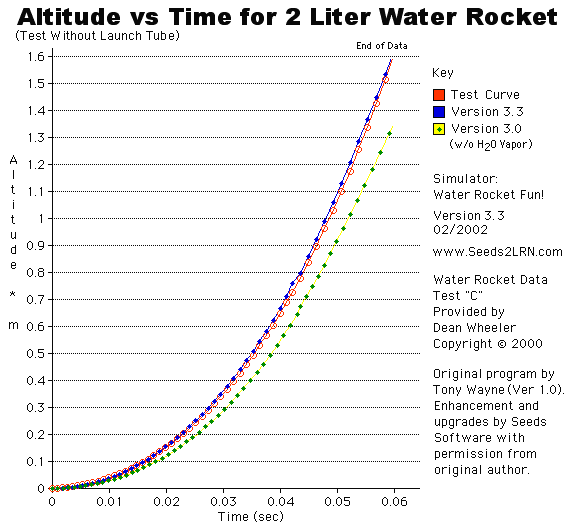
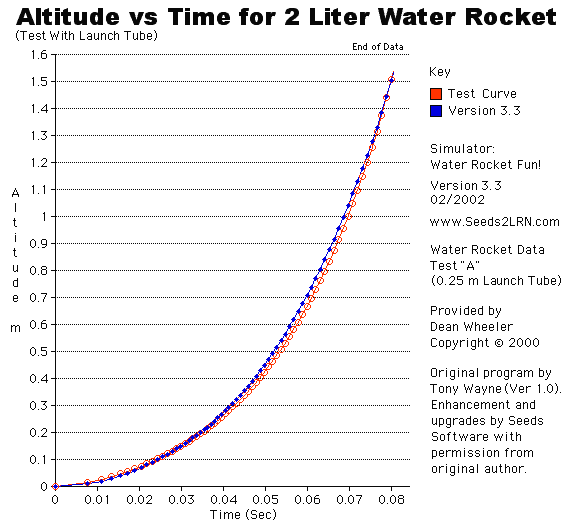
Software Revision History
For Extensive Information and Links on Water Rockets and Launchers:
Dean's Benchtop
Ph:(206)-782-0914, Fax: (206)-782-0918
E-mail: Questions & Support to "RealScience@Seeds2Learn.com"